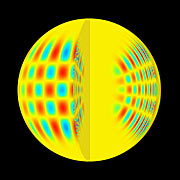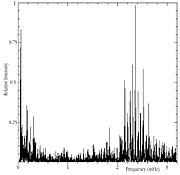Press Release
Sounds of a Star
Acoustic Oscillations in Solar-Twin "Alpha Cen A" Observed from La Silla by Swiss Team
28 June 2001
Sound waves running through a star can help astronomers reveal its inner properties. This particular branch of modern astrophysics is known as "asteroseismology". In the case of our Sun, the brightest star in the sky, such waves have been observed since some time, and have greatly improved our knowledge about what is going on inside. However, because they are much fainter, it has turned out to be very difficult to detect similar waves in other stars. Nevertheless, tiny oscillations in a solar-twin star have now been unambiguously detected by Swiss astronomers François Bouchy and Fabien Carrier from the Geneva Observatory, using the CORALIE spectrometer on the Swiss 1.2-metre Leonard Euler telescope at the ESO La Silla Observatory. This telescope is mostly used for discovering exoplanets. The star Alpha Centauri A is the nearest star visible to the naked eye, at a distance of a little more than 4 light-years. The new measurements show that it pulsates with a 7-minute cycle, very similar to what is observed in the Sun.
Asteroseismology for Sun-like stars is likely to become an important probe of stellar theory in the near future. The state-of-the-art HARPS spectrograph, to be mounted on the ESO 3.6-metre telescope at La Silla, will be able to search for oscillations in stars that are 100 times fainter than those for which such demanding observations are possible with CORALIE.
Asteroseismology: listening to the stars
Geologists monitor how seismic waves generated by earthquakes propagate through the Earth, and thus learn about the inner structure of our planet. The same technique works for stars. The Sun, our nearest star and a typical middle-age member of its class, has been investigated in this way since the 1960's. With "solar seismology", astronomers have been able to learn much about the inner parts of the star, and not only the outer layers normally visible to the telescopes.
In the Sun, heat is bubbling up from the central regions where enormous amount of energy is created by nuclear reactions. In the so-called convective zone, the gas is virtually boiling, and hot gas-bubbles are rising with a speed that is close to that of sound.
Much like you can hear when water starts to boil, the turbulent convection in the Sun creates noise . These sound waves then propagate through the solar interior and are reflected on the surface, making it oscillate. This "ringing" is well observed in the Sun, where the amplitude and frequency of the oscillations provide astronomers with plenty of information about the physical conditions in the solar interior.
From the Sun to the stars
There is every reason to believe that our Sun is a quite normal star of its type. Other stars that are similar to the Sun are therefore likely to pulsate in much the same way as the Sun. The search for such oscillations in other solar-like stars has, however, been a long and difficult one. The problem is simply that the pulsations are tiny, so very great precision is needed in the measurements.
However, the last few years have seen considerable progress in asteroseismology, and François Bouchy and Fabien Carrier from the Geneva Observatory have now been able to detect unambiguous acoustic oscillations in the Solar-twin star, Alpha Centauri A.
The bright and nearby star Alpha Centauri
Alpha Centauri (Alpha Cen) [1] is the brightest star in the constellation Centaurus in the southern hemisphere. It is actually a double star, consisting of the solar twin Alpha Cen A and its fainter companion Alpha Cen B.
A third star, Proxima Centauri, seems to be loosely connected with the binary. Proxima is, after the Sun, the nearest star we know now, only 4.3 light years away. However, Proxima is such a faint star that it can only be seen with a good telescope.
Alpha Centauri A is one of the brightest stars on the southern sky, and the closest star observable with the naked eye. Being a near twin to the Sun and very nearby - in astronomical terms - made this star the ideal candidate in the search for tiny oscillations.
The observational technique
The observations of Alpha Cen A were conducted in May 2001 during five nights at the Swiss 1.2-metre Leonard Euler telescope at the ESO La Silla Observatory.
The CORALIE spectrograph at this telescope is well known for its very successful programme of detecting exoplanets, c.f. ESO Press Release eso0114. In searching for exoplanets close to nearby stars, the spectrograph identifies the tiny wobbling motion of the star, induced by the gravitational pull of the unseen planetary companion.
The same technique was used for the investigation of oscillations in Alpha Cen A. The acoustic waves make the surface of the star periodically pulsate in and out, and the spectra of the stellar surface will show corresponding (very) small velocity shifts.
The detected oscillations only move with speeds of up to 35 cm per second. This means that the perturbations on the stellar surface only amount to some 40 metres up and down on a star with a radius of 875,000 kilometres, see also the illustration (ESO Press Photo eso0125). A very small change indeed, and not easy to detect with current astronomical instruments!
Acoustic waves in Alpha Centauri A
The data from five nights of observations were then searched to detect any changes of velocity and hence, oscillations. Astronomers use sophisticated mathematical methods for this kind of analysis, and normally present their results in terms of a "power spectrum" (ESO Press Photo eso0125). It displays the "intensity" of oscillations at different frequencies, that is, of different periods; particularly high "peaks" indicate a "real" oscillation of that frequency.
The comb of peaks visible between 2-3 mHz is the unambiguous and typical signature of solar-like oscillations. This frequency corresponds to a period of about 7 minutes, close to the well-known 5-minute oscillations of our Sun. This is in full agreement with expectations from theoretical models of the two stars. Continued detailed modeling of these new results will further improve the associated determination of the mass, radius, age, chemical composition and other properties of Alpha Cen A.
This result is another proof of the excellent performance of the CORALIE spectrograph, providing extremely accurate measurements without the present investigation would have been impossible.
Models of stellar interiors
Our current understanding of stellar interiors is severely limited by lack of detailed and accurate observations of stars other than the Sun. In technical terms, for a complete description of the conditions inside a star, we need detailed knowledge of at least five stellar parameters (mass, age, initial content of helium and heavier elements, and a parameter describing the convection). However, in most cases, only two stellar properties can be measured directly (the temperature and the luminosity), so the models are necessarily quite uncertain (i.e., they are not well "constrained").
It is therefore imperative to enlarge the number of observables and this is possible with asteroseismology. Helioseismology has opened up the way. These observations severely constrain the possible models of the Sun's internal structure. But, depending on their mass and age, stars have very different internal structures, and may also harbour physical processes that are quite different from those in the Sun.
Asteroseismological observations of stellar oscillations add crucial information that constrain the models of their inner structure, since the measured frequencies may be compared directly with those computed for the models. The observation of the full stellar disk allows to characterize certain (low degree) oscillation modes which penetrate deep inside the star and it is not necessary to resolve the stellar disk (as we can do for the Sun) in order to obtain useful seismological information.
More stars to be observed
Observations of bright solar-like stars are already planned with the CORALIE spectrograph. Even fainter stars can be observed with the HARPS spectrograph which will be installed on the 3.6-m telescope at La Silla Observatory at the end of 2002. It will be able to observe stars that are one hundred times fainter than those now reachable with CORALIE and with even better accuracy of the velocity measurements. While it will be mostly dedicated to the search of exoplanets, HARPS will be able to conduct an asteroseismological study of about 100 solar-like stars.
Notes
[1] Alpha Centauri was earlier known as Rigil Centauri, but that name is not much used because of the similarity with the name of the bright star Rigel in Orion. Alpha Centauri is one of the brightest stars in the sky (visual magnitude 0) and is a splendid view in the southern Milky Way, next to Beta Centauri. It was an object of worship on the Nile and the first visible emergence in the morning sky at the autumn equinox has been connected with the orientation of several temples in Northern and Southern Egypt from the fourth millenium B.C.
More information
The research reported in this Press Release is described in a scientific article ("P-mode observations on Alpha Cen A" by François Bouchy and Fabien Carrier) that has been accepted for publication as a Letter in the European journal "Astronomy & Astrophysics".
Contacts
François Bouchy
Geneva Observatory
Sauverny, Switzerland
Tel: +41-22-7552611
Email: Francois.Bouchy@obs.unige.ch
Fabien Carrier
Geneva Observatory
Sauverny, Switzerland
Tel: +41-22-7552611
Email: Fabien.Carrier@obs.unige.ch
About the Release
| Release No.: | eso0125 |
| Legacy ID: | PR 15/01 |
| Name: | Alpha Centauri A, Asteroseismology |
| Type: | Unspecified : Star : Evolutionary Stage : Main Sequence |
| Facility: | Swiss 1.2-metre Leonhard Euler Telescope |
| Instruments: | CORALIE |


